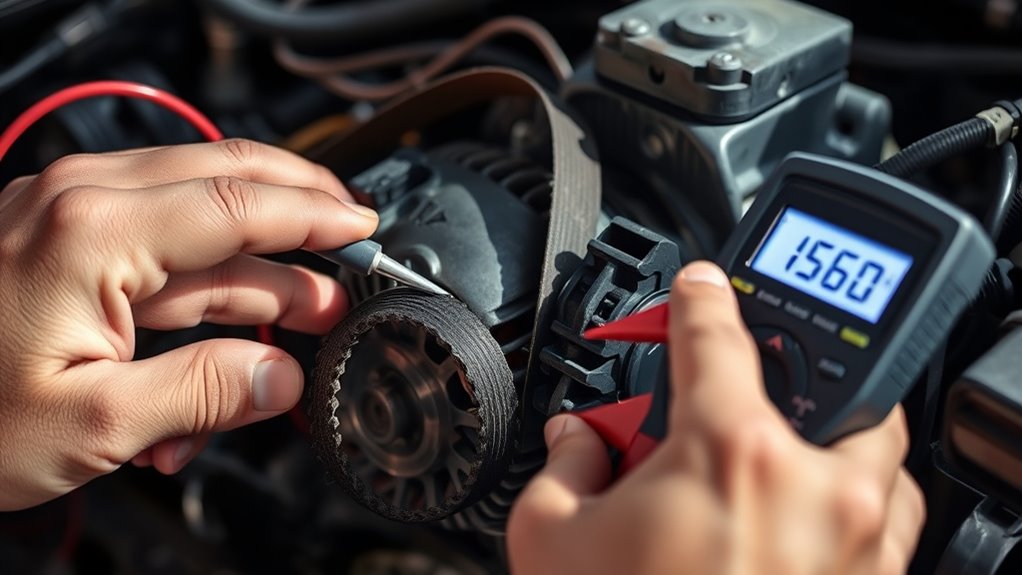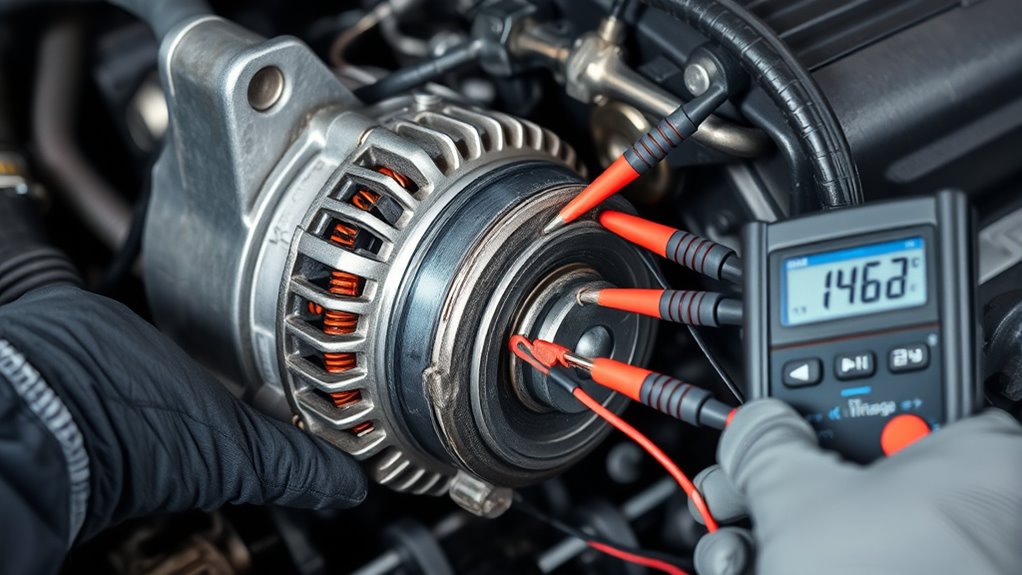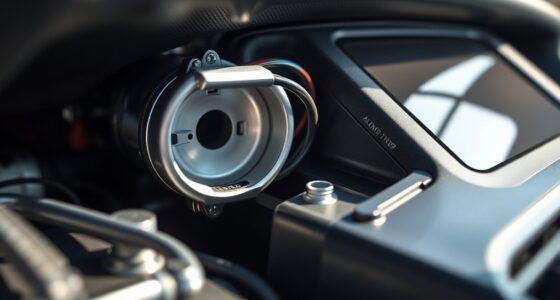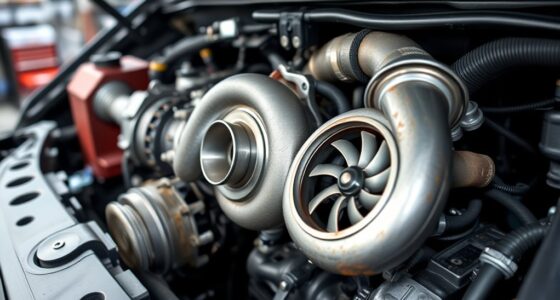If your alternator isn’t charging, start by checking the voltage at the battery terminals; it should rise to around 13.8–14.4 volts when the engine runs. Inspect the drive belt for cracks, fraying, or looseness—tighten or replace it if needed. Also, examine wiring connections for corrosion or damage and clean or tighten them. Addressing these issues can restore proper charging; if issues persist, there’s more to explore.
Key Takeaways
- Measure battery voltage with engine off and running; lack of voltage increase indicates charging issues.
- Inspect drive belt for cracks, glazing, or looseness; proper tension ensures efficient alternator operation.
- Check wiring connections for corrosion, damage, or looseness to maintain reliable electrical flow.
- Test alternator output voltage; below 13.8 volts suggests a faulty alternator needing replacement.
- Regularly monitor belt tension and electrical connections to prevent power loss and ensure proper charging.

If your vehicle’s battery keeps dying or the electrical systems are acting up, the alternator mightn’t be charging properly. This component is responsible for keeping your battery charged while you drive and powering your electrical systems. When it malfunctions, your car can quickly lose power, leaving you stranded. One of the common issues to check is voltage drop, which can reveal if your alternator isn’t delivering enough charge to the battery.
Using a multimeter, you can measure the voltage at the battery terminals with the engine off and then with it running. If the voltage doesn’t increase to about 13.8 to 14.4 volts when the engine is on, it indicates that the alternator isn’t charging correctly. A significant voltage drop between the alternator and the battery suggests poor connections, damaged wires, or a faulty alternator.
Next, you should examine the drive belt that connects the alternator to the engine. If the belt is worn, loose, cracked, or slipping, it won’t turn the alternator efficiently, which results in insufficient charging. Visually inspect the belt for signs of deterioration, paying attention to cracks, fraying, or glazing.
You should also check the tension by pressing down on the belt; it should have a slight give but shouldn’t be loose enough to slip off the pulley. A loose belt not only hampers charging but can also cause squealing noises, alerting you to a potential problem. If the belt is damaged or loose, replace or tighten it as needed. Proper tension ensures the alternator spins at the correct speed to generate enough electricity.
Beyond the belt, it’s essential to inspect the wiring and connections. Corrosion, loose terminals, or damaged wires can prevent the alternator from charging the battery efficiently. Remove any corrosion from the battery terminals and cable ends using a wire brush, and tighten any loose connections.
Also, check the wiring harness that connects to the alternator for signs of damage or corrosion. If you find frayed or broken wires, replace them to restore proper electrical flow. Sometimes, the issue isn’t with the belt or wiring but with the alternator itself. In such cases, testing the alternator’s output using a multimeter or having a professional do it can confirm if it needs replacement.
Addressing voltage drop and belt issues is vital for diagnosing an alternator that isn’t charging. Taking these steps promptly can prevent your vehicle from losing power unexpectedly and extend the lifespan of your battery and electrical system.
Additionally, keeping an eye on the AI security implications of modern vehicle electronics can help ensure your vehicle’s systems are protected from cyber threats. Regular inspections of the belt tension, connections, and voltage output help catch problems early, saving you time and money in the long run. Keep a close eye on these components, especially if your car shows signs of electrical trouble, so you can maintain a reliable and smooth-running vehicle.
Frequently Asked Questions
Can a Bad Battery Cause Alternator Charging Issues?
Yes, a bad battery can cause alternator charging issues. When your battery is weak or failing, it may not hold a proper charge or send the correct signal to the alternator.
This can lead to the alternator not charging effectively, causing electrical problems in your vehicle.
Always check your battery’s health first, as a faulty battery often mimics or contributes to charging system problems.
How Long Does an Alternator Typically Last?
An alternator typically lasts between 80,000 and 150,000 miles, but it’s not a set rule. Think of it like a marathon—your driving habits, climate, and maintenance influence how long it keeps going.
If you notice dimming lights or a dead battery, it’s a sign your alternator may be nearing the finish line. Regular checks can help you catch problems early and extend its lifespan.
Are Aftermarket Alternators Reliable Replacements?
Aftermarket alternators can be reliable replacements if you choose quality brands. They often cost less and are easier to find than OEM parts.
However, their reliability depends on the brand and installation. You should research reviews and verify compatibility with your vehicle.
Proper installation and regular maintenance are essential. When you select a reputable brand, you’re more likely to get a durable, efficient alternator that keeps your electrical system running smoothly.
What Tools Are Needed for Alternator Testing?
Testing your alternator is like diagnosing a silent hero in your car’s engine. You’ll need a digital multimeter to measure voltage, ensuring it’s between 13.8 and 14.8 volts when the engine runs.
A socket wrench helps remove the belt if needed, and a fuse tester confirms circuit integrity. These tools give you a clear picture of your alternator’s health, helping you catch issues early before they become costly.
Can Wiring Harness Problems Affect Charging?
Yes, wiring harness problems can affect charging. Damaged, loose, or corroded wiring can interrupt the flow of electrical current between your alternator and battery. This disruption prevents the system from charging properly.
You should inspect the wiring harness for any visible damage or corrosion, ensuring all connections are tight and clean. Replacing or repairing faulty wiring can restore proper charging and prevent further electrical issues.
Conclusion
So, next time your dash lights flicker or your battery dies unexpectedly, remember—your alternator might just be playing hide and seek. It’s ironic how a simple belt or voltage drop can turn your drive into a dead-end. Don’t ignore those warning signs; otherwise, you’ll end up wishing you checked those little things earlier. After all, a healthy alternator is the silent hero keeping your car alive—until it’s not.









